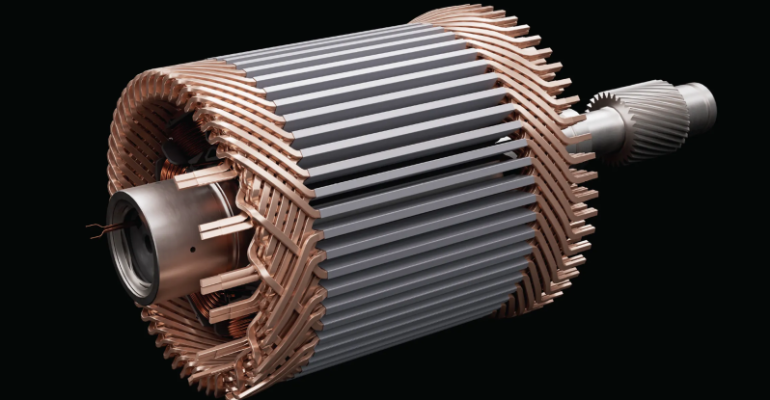Rare Earth Magnets May Demolish EV Dreams
Dr Arunaditya Sahay
Both internal combustion engine (ICE) and battery powered vehicles serve the same
purpose of transportation. Whereas ICE vehicles use fossil fuel for energy, electric
vehicles use battery for powering electric vehicles (EV). The internal combustion engine
converts chemical energy into mechanical energy whereas the electric motor in EVs
converts the electrical energy into mechanical energy. Whenever we talk of EVs, the
purchase decision, apart from the cost, hinges around battery specifications. No doubt,
the battery of an electric Vehicle is the most important component but next to the
battery, the most important component of EV is the electric motor that needs to be
light weight, temperature resistant and must have high performing magnet. There are
four categories of permanent magnets; they are neodymium iron boron (NdFeB),
samarium cobalt (SmCo), alnico, and ceramic or ferrite magnets. Out of these
neodymium, iron and boron (Nd-Fe-B) permanent magnets, belonging to rare earth
elements (REE), are most suitable for EVs as they can withstand temperatures as high
as 230 degrees centigrade. Besides EV motors, they are also used for a variety of other
conventional automotive subsystems, such as anti-lock brakes, power steering, electric
windows, power seats, and audio speakers. In addition, REEs find use in satellite
communications, guidance systems, aircraft structures, computer hard disk drives, CDROMs, digital cameras, etc.
For the economic development and national security, Government of India have
defined critical materials to which REEs, too, belong. The lack of availability of these
minerals; if available the concentration of existence, the difficulty in extraction and
processing of these elements in few geographical locations in the world has led to
supply chain vulnerability disrupting national plans. The rare earth elements (REEs)
consist of 17 metals in Group 3 of the Periodic Table. They comprise of Lanthanide series
elements, Scandium and Yttrium (because of similar physical properties and found in
the same ores and deposits). Contrary to their name, they are moderately abundant in
nature but not concentrated enough to make them economically exploitable. India has
the fifth-largest rare earth resource globally (Table Below), the Indian REEs being mainly
concentrated in its monazite minerals.
| Global Availability of REEs | ||
| Country | Reserves of REEs (in tons of Oxide) | % Share |
| Australia | 3.400.000 | 2.56 |
| BraziI | 22.000.000 | 16.67 |
| Canada | 830 | 0.63 |
| China | 44 | 33.33 |
| Greenland | 1.5 | 1.14 |
| India | 6,900.00 | 5.23 |
| Malaysia | 30 | 0.02 |
| Malawi | 140 | 0.11 |
| Russia | 18.000.000 | 13.64 |
| South Africa | 8,60.000 | 0.65 |
| Vietnam | 2,20,00,000 | 16.67 |
| USA | 1.400.000 | 1.06 |
| World Reserves | 13,20,00,000 | 100 |
April 4, 2025 was the black day in the history of REEs when China’s Ministry of
Commerce imposed export restrictions on seven rare earth elements (REEs) as well as
on manufactured magnets which are used in many sectors of economy including
automotive, defence, and energy. This action was taken in retaliation to U.S. President
Donald Trump’s astronomical tariff increase on Chinese products. Unfortunately, India,
too, is caught in this cross fire between China and Russia. India’s position for REE and
magnet import from China has become further difficult with ‘Operation Sindoor’ that
resulted in India getting the custody of Chinese PL 15E missiles, both live and destroyed.
The new restrictions on export has been imposed on 7 of 17 REEs. These include
samarium, gadolinium, terbium, dysprosium, lutetium, scandium, and yttrium. The
Chinese companies need to secure special export license to export not only the minerals
but also permanent magnets. Apart from the tariffs, the cold war between China and
USA may be another cause for this retaliation as REEs, in addition to automobile and
energy, are crucial for a range of technologies in defence. They are used in F-35 fighter
jets, Virginia and Columbia class submarines, Tomahawk missiles, radar systems,
Predator unmanned aerial vehicles, and the Joint Direct Attack Munition series of smart
bombs. It will not be out of context to mention that F-35 fighter jet contains over 900
pounds of REEs whereas DDG-51, an Arleigh Burke class destroyer and Virginia class
submarine require approximately 5,200 pounds and 9,200 pounds respectively of rare
earth elements. Unfortunately, India, too, is caught in this cross fire between China and
Russia.
Until 2023, China accounted for 99% of world’s heavy Rare Earth Elements processing.
Vietnam, too, was doing REEs processing for names sake but their processing facility has
been closed down due to a tax dispute that arose during the last year. This gave China
a monopolistic position over the global supply of REEs. As of now, the United States is
on the back foot when it comes to manufacturing defence equipment which is based on
technologies that use REEs. To thwart this precarious situation, the United States has
caught hold of a Canadian Company, Aclara Resources, which will mine rare-earths in
Brazil, having second highest deposits of REEs, to supply a processing plant that the firm
has planned to build in U.S.A. This plant will be separating rare-earths deposits into
individual elements. Post this announcement, Aclara is facing a tsunami of demand as
the whole western world is seeking to establish alternative supply chain for REEs and
magnets needed by vital industries.
While India has fifth largest REE reserves, it lacks the advanced extraction and refining
capabilities, making her heavily dependent on China. Thus, India is in a difficult position
with regard to REEs and magnets. No doubt, Indian Rare Earth Limited has started
making magnets in its Vizag plant (annual capacity of 3,000 kg), the magnets produced
are samarium-cobalt permanent magnets. based on indigenous technology developed
by Bhabha Atomic Research Centre (BARC) and Defence Metallurgical Research
Laboratory (DMRL) using indigenous rare earth – Samarium. These magnets find
applications requiring high thermal stability, corrosion resistance, and reliable
performance in harsh environments, such as aerospace, military, and high-temperature
industrial uses. EVs, on the other hand, require high magnetic strength in compact sizes,
suitable for electric motors, that is fulfilled by Nd-Fe-B magnets which are imported
from China. Because of the restriction imposed by China on the export of these
magnets, Indian top EV manufacturers have already reached out to the Central
government through associated Ministries seeking their intervention to ensure
continued supply of critical minerals including rare earth elements (REE) as well as
magnets from China. PM schemes on green mobility is in jeopardy because of supply
restrictions by China. Price rise in EVs is imminent if shortages of supplies continue. Rare
earth magnets, particularly neodymium-iron-boron (NdFeB) magnets, are vital in EV
manufacturing. They provide strong magnetic fields that are required for the high
efficiency and performance of electric motors, especially traction motors that drive EVs.
Apart from other procedural hindrances, China is seeking government guarantee that
these critical mineral sources from them will not be used in weapon-making and will be
restricted for civilian usage only.
Last month, some of the EV makers had reached out to various connected Ministry
seeking continuity in supply of REEs, including these magnets. Though India has world’s
fifth largest deposit of REEs, the concentration of the required materials for EV is very
low. Even if a decision is taken to be self-dependent for REEs and EV magnets, the
gestation period for establishing a mine is very high and the extraction of the metals
from the mineral will require technology procurement/development. Therefore, for
short run, there is no alternative than to get the REEs/magnets from China whose new
policy is that rare earth magnets will be supplied to only those countries which provide
end-user certificates to Chinese suppliers in the prescribed format. It required further
that the importers must confirm that the magnets will not be used in weapons or
transferred to any third party. This declaration by the importers has to be certified by
the Ministry of External Affairs and sent to the Chinese exporter throu the Embassy of
China. According to the Automotive manufacturers represented by SIAM, the magnet
inventories is likely to last only till the end of June. Taking advantage of the situation,
the Chinese government is pressuring Indian EV manufacturers to import assembled
motors rather than the magnet used in the motor. This will not only increase the price
of the EV but also require design changes to fit Chinese motor in the assembly which
will further increase the cost and take considerable time for implementation. Both the EV industry, the central government and all connected ministries have to act fast so that
India’s EV dream is not shattered.
*Former CEO, SIL, presently Distinguished Professor, FSM
Categories
Latest Posts
Rare Earth Magnets May Demolish EV Dreams
May 26, 2025Are EVs Environment Friendly?
May 22, 2025B





